House price rises continue in Australia
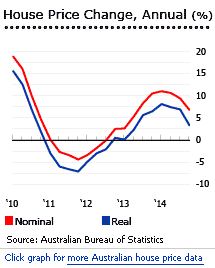 House prices rose by 6.8% in Australia's eight major cities in 2014 (3.34% inflation-adjusted), after a rise of 9.48% during 2013 (6.47% inflation-adjusted), based on figures from the Australian Bureau of Statistics (ABS). House prices increased 1.9% quarter-on-quarter in Q4 2014.
House prices rose by 6.8% in Australia's eight major cities in 2014 (3.34% inflation-adjusted), after a rise of 9.48% during 2013 (6.47% inflation-adjusted), based on figures from the Australian Bureau of Statistics (ABS). House prices increased 1.9% quarter-on-quarter in Q4 2014.
Sydney saw the biggest increase, with house prices up by 12.2% in 2014, followed by Brisbane (5.3%), Melbourne (4.5%), and Adelaide (2.5%). House prices also rose in Hobart (2.2%), Canberra (1.7%), Perth (1.2%), and Darwin (0.8%).
New South Wales, especially Sydney, has the most expensive housing in the country, with the median house price at AU$ 760,000 (US$ 591,962), about 33% above the national median house price of AU$ 571,500 (US$ 448,313), according to ABS.
Some critics believe that Australia's housing market is severely overvalued.
Yet demand is still rising. Seasonally-adjusted purchases of established dwellings increased 4.0% to 44,912 units in 2014, according to ABS. Finance commitments for owner-occupied housing rose by 4.3% to 53,920, while their total value jumped 19.4%, to AU$ 18,043 billion (US$ 14,053 billion).
These price-rises are somewhat surprising, since Australia's economy is estimated to have grown by a modest 2.7% in 2014, up from 2.5% in 2013, after GDP growth of 3.7% in 2012, 2.4% in 2011, 2.6% in 2010 and 1.4% in 2009, according to the IMF. However two factors may partially explain it. The Reserve Bank of Australia (RBA) has kept its cash rate at a record low of 2.25%, after cutting it by 25 basis points in February 2015. The other factor is increased purchases of residential real estate by foreign nationals, especially Chinese, who continue to find Australian property very attractive. Australia's Foreign Investment Review Board (FIRB) grave permission for 11,668 residential property purchases by foreigners in 2012-13, to a value of AU$17 billion (US$15.21 billion), an increase of 19% on the previous financial year, according to the FIRB.
Acquisition of residential real estate by foreign nationals and corporations is subject to Foreign Investment Review Board (FIRB) approval.
Australia’s housing boom; crash avoided
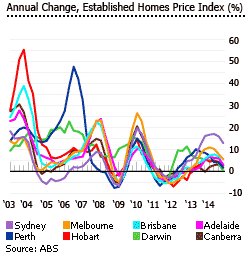
The strength of Australia’s housing market through the recession surprised observers, who had predicted that Australia would suffer one of the worst housing market crashes, because of house price overvaluation.
One reason a crash was avoided was that lending standards have been stricter than in the US. In addition, the government helped first-time homebuyers, introducing a AU$10.4 billion (US$7.24 billion) stimulus package in October 14, 2008 - worth around 1% of GDP - which included the First Home Owner Boost Scheme (FHOB), which raised the First Home Owner Grant (FHOG) from AU$7,000 (US$6,419) to AU$14,000 (US$12,838) for existing dwellings, and to AU$21,000 (AU$19,257) for newly built homes (however, the FHOG reverted back to $7,000 in December 2009 in NSW, and reduced it in other states).
There are also housing shortages due to a rapidly growing population, and in a context of shrinking Australian household sizes. There was also strong immigration from 2004 to 2007.
Housing remains “severely unaffordable”
Among the seven developed nations covered by the 11th Annual Demographia International Housing Affordability Survey, Australia ranks third as most unaffordable major market.
The survey uses the Median Multiple to assess housing affordability in 378 markets in Australia, Canada, China (Hong Kong), Japan, Singapore, Ireland, New Zealand, the United Kingdom, and the United States. The Median Multiple follows this formula: Median Multiple = median house prices / median household income.
Of the 51 Australian markets surveyed in 2014, 33 were rated “severely unaffordable” (Median Multiple of 5.1 and above), 15 were “seriously unaffordable” (Median Multiple between 4.1 and 5.0), 1 was rated moderately affordable (3.1-4.0), and 2 markets evaluated as affordable (3.0 & under).
Sydney continued to be one of the world's most unaffordable major markets next to Vancouver and Hong Kong, and is the least affordable market in Australia, with a Median Multiple of 9.8. Outside the major markets, the Tweed Heads (Queensland), is the most severely unaffordable market, with a Median Multiple of 9.1.
Dr Andrew Wilson, senior economist of the Fairfax-owned Australia Property Monitors (APM), recently warned that Sydney house prices are in “hyperdrive".
Yet based on Commonwealth Bank of Australia’s recent Home Buyer Affordability Report in March 2014, housing affordability has recently improved.
“Overall, the trend across the capital cities is one of continued improvement in affordability, with the capital city index increasing by 2.0 per cent in the March 2013 quarter. However the cities of Adelaide, Perth and Hobart each saw declines in affordability,” according to HIA Senior Economist Shane Garrett.
Moderate yields, but rent hikes continue
Rental yields in Australia are moderate. Gross rental yields for houses range from 4.08% in Melbourne, to 5.44% in Hobart, according to the December 2014 figures of Australian Property Monitors (APM). Gross rental yields for apartment units range from 4.60% in Melbourne to 5.68% in Darwin. Our own yields research for Australia is now rather old (Global Property Guide Research of October 2012). Back then, in Sydney, smaller apartment units of around 60 sq. m. had gross rental yields of 6.26%. 100 sq. m. and 150 sq. m. apartments had lower yields at around 4.94% and 3.93%, respectively.
The average asking rent on houses, in the eight capital cities, fell (-1.4%) during the year to Q4 2014. During the same period, the average asking rent on ‘units’ decreased by (-0.6%). On a national level, asking rents for houses were up by only 0.6% q-o-q to Q4 2014, while ‘unit’ rents were down by 0.1% during the same quarter.
“Sydney rents continue to rise despite record activity from investors over the past year and remain the highest of all the state capitals,” says APM's Dr. Wilson. "The median asking rent for houses increased to a new peak of $520 per week for an overall increase of 4 per cent in 2014. Despite a surge in the supply of new apartments, Sydney unit rents increased over the quarter, regaining the previous high of $500 a week."
The highest median weekly asking rents can be found in Darwin, with houses at around AU$ 660 (US$ 517.74) and units at AU$550 (US$ 431.45), followed by Sydney with median rents at AU$ 520 (US$ 407.91) for houses and AU$ 500 (US$ 392.23) for units. Hobart has the lowest median weekly asking rents at AU$ 320 (US$ 251.02) for houses and AU$ 270 (U$ 211.80) for units.
“Upward pressure on rents is set to continue through 2015, particularly in the robust Sydney market where underlying demand continues to outstrip supply. Increased supply of new units in Brisbane and Melbourne will, however, continue to provide more choice for tenants with lower rental growth a prospect,” says Dr. Wilson.
Key interest rate on hold
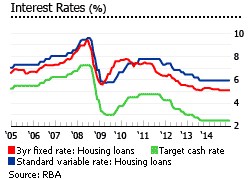
The Reserve Bank of Australia (RBA) cut the official cash rate by 25 basis points, from 2.5% to a new record low of 2.25%, in February 2015. This is the first interest cut in 18 months.
One possible driver for the surprise decision to cut could be the stubbornly high Aussie dollar. Even with the recent 18% plunge in the past 6 months, the Australian dollar still remained above its “fundamental value, particularly given the significant declines in key commodity prices,” the central bank noted.
Mortgage market continues to grow.
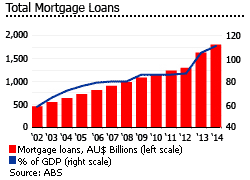
In 2014, loans to both investors, and to owner occupiers for house building increased. During the last quarter of 2014 quarter, these loans increased to a level 7.1%, higher than 5.4% in the last quarter of 2013, according to Reserve Bank of Australia.
The Australian mortgage market has grown from around 15% of GDP in the 1970s, to 87% of GDP in 2012.
‘Housing construction loans, in both the owner occupier and investor segments of the market, finished 2014 on a strong note. This provides a very positive signal for activity in the residential construction sector in 2015,’ said Housing Industry Association economist, Diwa Hopkins.
Residential construction up
Residential construction activity continues to rise. Dwelling unit approvals soared by 8.8% to 17,753 units in 2014, up from according to the ABS; new residential building consents rose by 0.6% to AU$ 5,400 billion (US$ 4,236 billion), both figures seasonally-adjusted.

However, there remains a shortage of affordable housing, driving those at the bottom of the market to become renters instead of buying, and struggling with high rents.
Australia’s affordability problem is partly attributed to insufficient construction of new houses. Australia has been under-building new residential dwellings in the past years, for several reasons.
- Stringent urban planning policies and land use restrictions (called ‘smart growth’, ‘urban containment’, etc.). “An increase in state government zoning regulations is a significant factor driving up the cost of housing”, said Reserve Bank of Australia Governor Glenn Stevens.
- Tax burdens on builders and developers. In New South Wales, government taxes and other charges are estimated to account for about 30% of the price of new houses.
- Due to the global credit crunch, developers continue to struggle to secure finance.
In 2012, housing starts fell by 2.2%, after a 11.3% drop in 2011. Residential construction recovered in 2013 rose by 21.8%, driven by interest rate cuts, new home incentives in some states, and focus on policy reform in New South Wales.
Australia’s much hyped housing bubble was attributed to the RBA’s decision to cut its Official Cash Rate to 2.25% on February 2015.
Modest economic growth, high unemployment
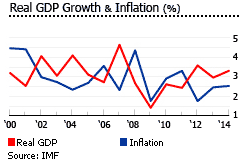
In the fourth quarter of 2014, Australia’s economic growth accelerated to 2.7% from a year earlier, down from an annual growth rate of 2.8% the previous year, fuelled by increases in household spending and exports, according to the Reserve Bank of Australia (RBA), the country’s central bank.
The RBA expects that the economy will grow by 2.75% this year, pinning its hopes on lower interest rates and a falling dollar. The Australian dollar (AUD) appreciated by more than (-11%) from AUD 0.8763 = USD1 in January 2014 to AUD 0.7781 = USD1 in January 2015.
Australia’s export industry is now improving. In Q3 2014, the country’s current account deficit narrowed to a record AU$ 12,525 million (US$ 9,825 million), down from a previous deficit of AU$ 13,742 (US$ 10,780). Despite this, demand from China remains unstable, according to the RBA.
In December 2014, the nationwide unemployment rate rose to 6.1%, the highest level since July 2003, according to RBA.
Consumer prices rose 1.7% in Q4 2014 from a year earlier, slightly up, but still consistent with the central bank‘s 2%-3% inflation target, according to the ABS. The increase in inflation rate is mainly attributed to rises in costs of domestic holiday travel and accommodation, tobacco, and new dwelling purchase by owner-occupiers.